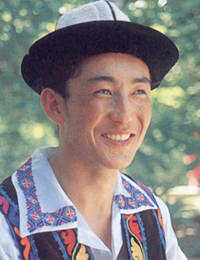| About China > People > Ethnic Groups |
|
|
Kirgiz Ethnic Minority
The Kirgiz created their own language, belonging to the Turkic subdivision of the Altaic Phylum. In the 1950s, a new alphabet was devised, discarding the old Arabic script and adopting a Roman alphabet-based script. The Kirgiz in south Xinjiang speak the Uygur language and those in north Xinjiang speak the Kazak language. The Chinese language is also used by the Kirgiz in some localities.
The forefathers of the Kirgiz people lived in the upper reaches of the Yenisey River. In the mid-sixth century, the Kirgiz tribe was under the rule of the Turkic Khanate. After the Tang Dynasty (618-907) defeated the Eastern Turkic Khanate, the Kirgiz came into contact with the dynasty and in the seventh century the Kirgiz land was officially included in China's territory. The ancient Kirgiz mixed with the Turki, Mongolian and Uygur people, thus creating the features of the current Kirgiz people.
Having lived a herding life for generations, their life is still closely related to animal husbandry -- garments, food and dwellings -- all distinctively feature nomadism. They like bright red, so their decorative art is always brightly colored in red and full of freshness and vitality.
They believe in Islam and avoid meat of pigs, dogs, cats, mice and other ferocious animals. As with other nationalities of Islamic faith, the Kirgiz celebrate the Kaizhai Festival, Corban Festival and Almsgiving Festival.
In the Kirgiz calendar, similar to that of the Han people, the years are designated as years of the rat, ox, tiger, rabbit, fish, snake, horse, sheep, fox, chicken, dog and pig. The appearance of the new moon marks the beginning of a month, 12 months form a year and 12 years is a cycle. At the beginning of the first month of the year, the Kirgiz people celebrate a festival similar to the Spring Festival. |
||
All rights reserved. Reproduction of text for non-commercial purposes is permitted provided that both the source and author are acknowledged and a notifying email is sent to us. |
||
 |
